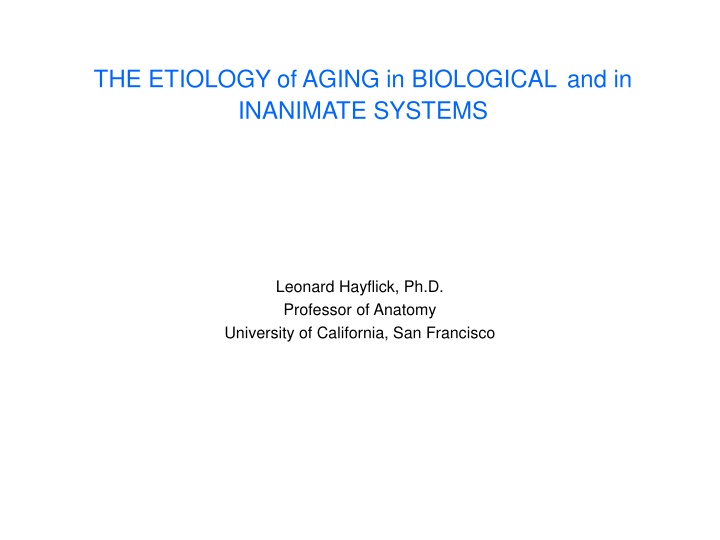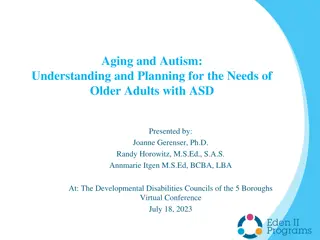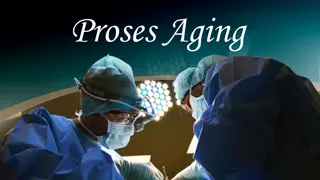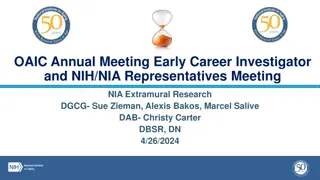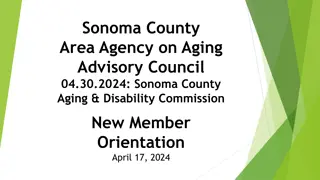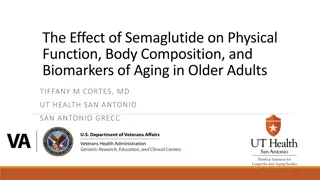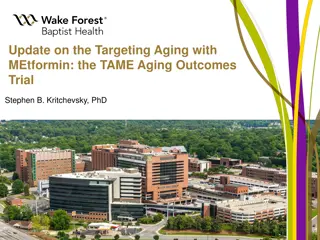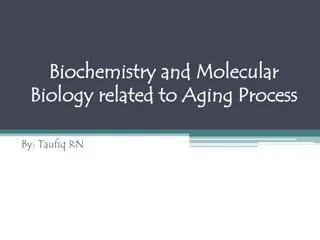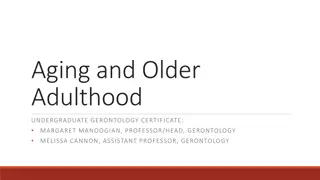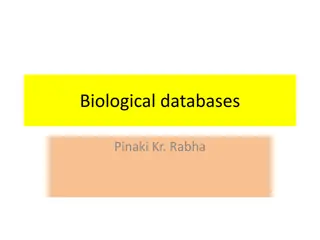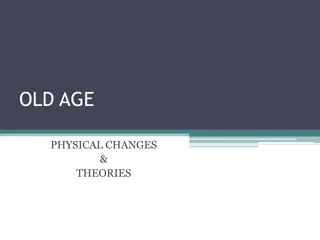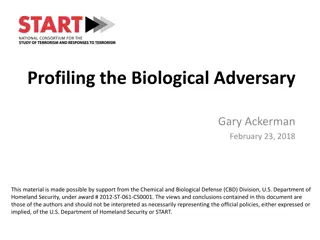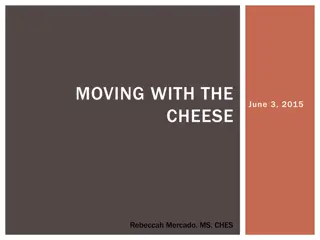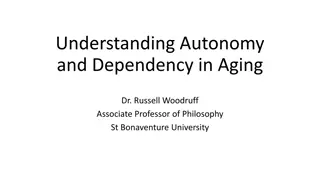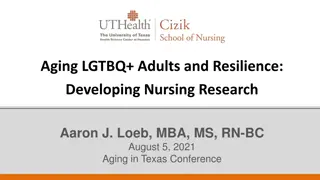Unveiling the Etiology of Aging in Biological Systems
The etiology of aging in both biological and inanimate systems explores the concept that aging may not be driven by genetic programming but rather result from stochastic processes. The loss of molecular structure is a key feature of age-related changes. The Second Law of Thermodynamics is suggested as a probable cause of aging, governing the behavior of molecules universally across animate and inanimate objects. Genes are deemed unnecessary to determine aging, and human aging exhibits unique characteristics.
Download Presentation

Please find below an Image/Link to download the presentation.
The content on the website is provided AS IS for your information and personal use only. It may not be sold, licensed, or shared on other websites without obtaining consent from the author.If you encounter any issues during the download, it is possible that the publisher has removed the file from their server.
You are allowed to download the files provided on this website for personal or commercial use, subject to the condition that they are used lawfully. All files are the property of their respective owners.
The content on the website is provided AS IS for your information and personal use only. It may not be sold, licensed, or shared on other websites without obtaining consent from the author.
E N D
Presentation Transcript
THE ETIOLOGY of AGING in BIOLOGICAL and in INANIMATE SYSTEMS Leonard Hayflick, Ph.D. Professor of Anatomy University of California, San Francisco
THERE ARE ONLY TWO WAYS IN WHICH AGE CHANGES CAN OCCUR (1) A purposeful program driven by genes. or (2) A stochastic or randomly occurring cascade of accidental events.
IN LIVING SYSTEMS THERE ARE FOUR ASPECTS OF THE FINITUDE OF LIFE 1. Aging 2. Longevity Determination 3. Age-associated Diseases 4. Death
EVIDENCE THAT AGING IS A STOCHASTIC PROCESS There is no direct evidence that supports the common belief that aging is the result of a genetic program. No gene that codes for a generally accepted biomarker of aging has been found. Animate and inanimate objects require no instructions to age. Everything in the universe ages and for the same reason. For example, your car is brilliant because it knows how to age without any instructions that exist either in the car itself or in the blueprints. A huge body of knowledge exists indicating that age changes are characterized by the loss of molecular structure in the molecules of both animate and inanimate objects.
WHY IS THE 2NDLAW THE PROBABLE CAUSE OF AGING? It: governs the behavior of all molecules can explain the ultimate cause of all other theories of aging is testable using current technologies is falsifiable is universal and applies to both animate and inanimate objects
WHY IS AGING NOT DETERMINED BY GENES? Genes are unnecessary to drive a spontaneous process. Blueprints contain no information to instruct a car, - or any other inanimate object, - how to age. Age changes are universal phenomena. Analogously, the genome also does not contain instructions that govern age changes.
HUMAN AGING IS UNIQUE The extreme manifestations of aging are unique to humans and the animals that we choose to protect. Feral animals do not age because when the process starts they are culled by predation, disease or accidents. By learning how to eliminate predators, prevent or delay diseases and accidents, we have revealed age changes in their extreme. We might argue teleologically that aging was never intended for us to experience. Aging then is an artifact of human civilization.
THE SECOND ASPECT OF THE FINITUDE OF LIFE: LONGEVITY DETERMINATION Rembrandt van Rijn 1606-1669
AGE CHANGES MUST OCCUR IN MOLECULES THAT FIRST EXIST WITHOUT AGE CHANGES Longevity is determined by the length of time that repair, synthesis and maintenance processes can retain the active state of biomolecules. When molecules composing the repair, synthesis and maintenance processes themselves eventually succumb to the same irreparable reduced energy states as do their substrate molecules, the aging process becomes manifest at higher levels of organization. The repair shops also age.
THE GENOME INDIRECTLY DETERMINES LONGEVITY The genome governs events from life's beginning until reproductive maturation after which many of the events that it continues to govern are overtaken by the aging process. From conception to adulthood, the efficiency of repair, synthesis and maintenance of molecules is favored over the continued loss of molecular structure in substrate molecules. After reproductive success the balance slowly shifts as dysfunctional molecules accumulate because their numbers exceed repair and maintenance capacity.
THE GENOME INDIRECTLY DETERMINES LONGEVITY Unlike the chance process that characterizes aging, longevity determination is not a chance process. Longevity is governed by the enormous excess capacity, (or physiological reserve), reached at the time of reproductive maturity (For example: two kidneys, two lungs, huge heart capacity.) This redundancy is achieved through natural selection to better guarantee survival to the age of reproductive success. Thus, the determination of longevity is incidental to the main goal of the genome which is to reach reproductive maturity.
AGING DETERMINANTS vs. LONGEVITY DETERMINANTS Longevity determination is an entirely different process from the aging process. One might think of longevity determination as the energy state of molecules before they incur age changes. ( Why do we live as long as we do? ) One might think of aging as the state of molecules as they continue to incur energy losses, become irreparable and dysfunctional. ( Why do things eventually go wrong? ) Aging, then, is a catabolic process that is chance driven. Longevity determination is an anabolic process that, indirectly, is genome driven.
THE THIRD ASPECT OF THE FINITUDE OF LIFE: AGE-ASSOCIATED DISEASES Six reasons why aging is not a disease:
UNLIKE ANY DISEASE: 1. Age changes occur in every animal that reaches a fixed size in adulthood. 2. Age changes occur in almost every species except those that continue to grow where aging does not occur or the rate is imperceptible. 3. Age changes occur in all species members only after the age of reproductive maturation. 4. Age changes occur in zoo animals protected by humans even after that species probably has not experienced aging for thousands or even millions of years in feral circumstances. 5. Age changes increase the vulnerability to pathology and death in all animals in which it occurs. 6. Age changes have the same universal molecular cause, (accumulation of dysfunctional molecules) in both animate and inanimate objects. THERE IS NO DISEASE OR PATHOLOGY THAT SHARES THESE SIX CRITERIA THAT CHARACTERIZE THE AGING PROCESS.
WILL DISEASE RESOLUTION INCREASE OUR UNDERSTANDING OF THE FUNDAMENTAL BIOLOGY OF AGING? Our success in resolving childhood diseases like poliomyelitis, iron deficiency anemia or Wilms tumors did not increase our understanding of childhood development. Similarly, the resolution of the leading causes of death (age-associated cardiovascular disease, stroke respiratory diseases and cancer) will provide no new insights into the fundamental etiology of aging.
WHAT IF ALL LEADING CAUSES WRITTEN ON DEATH CERTIFICATES WERE TO BE RESOLVED? In developed countries there could only be an increase in life expectancy of about 13 years. 79 years is the average life expectancy at birth in the U.S. today. Thus, about 92 years would be the maximum average life expectancy attainable if all causes of death were to be resolved. The increase in years of life expectancy if leading causes of death were resolved: At birth At age 65 Cardiovascular diseases and stroke 6.73 6.25 Cancer 3.4 2.19 Accidents 0.92 0.14 All other causes 4.29 1.71 (Anderson RN, U.S. Decennial Life Tables for 1989 91, Vol. 1, No. 4.US life tables eliminating certain causes of death. Hyattsville,MD: Nat. Ctr. for Health Statistics; 1999:7 8. ); Olshansky, Carnes and Cassel, Science, 1990)
IF ALL CAUSES OF DEATH CURRENTLY WRITTEN ON DEATH CERTIFICATES WOULD BE RESOLVED THEN WHAT WOULD CAUSE DEATH? Manifestations of the aging process would be the cause of most deaths. (Accidents, homicide, wars and suicide may never be eliminated.) The aging process, which commonly begins well before most age-associated diseases appear, would continue. A new vocabulary would be required to describe causes of death attributable to the loss of physiological capacity in some vital organ.
WHY ARE MOST DISEASES AGE-ASSOCIATED? The milieu created by the appearance, and/or the accumulation, of 2nd Law induced dysfunctional biomolecules provides conditions that increase vulnerability for further modifications that lead to the appearance of age-associated diseases. The dysfunctional molecules that also appear in repair, synthesis and disposal systems accelerate the aging process and further increase vulnerability to pathology. Unlike what occurs in young cells, the increasing accumulation of unrepaired, or retained dysfunctional molecules explains the occurrence of age-associated trivial phenomena (gray hair, age spots, presbyopia, wrinkles) or serious pathology, (cardiovascular disease, cancer, stroke). This reasoning suggests that all age associated diseases may have a common etiology that is favored by the milieu of old cells.
HOW OLD IS A LIVING FORM IF ALL OF ITS MOLECULES TURNOVER PERIODICALLY? Most of our cells present today were formed no more than a few years ago. Some were formed a few minutes, or fractions of a second, ago. We do not know of any cells or molecules proven to be present at birth and that survive to our present age. After about 20 population doublings the smallest molecules are discarded or diluted to the vanishing point. Thus, the essential quality of the sameness of the organism ultimately disappears. If all of our cells, or the molecules that compose them, turnover in only a few years then what do you celebrate on your birthdays?
INFORMATION DOES NOT AGE DNA, even in gametes and their precursors, is not immortal (despite Weismann s claim that germ cells are immortal) but the information it contains comes close. DNA turns over. Because of the essential role of mutations and recombination, information in DNA changes. The only aspect of biology that approaches (but does not achieve) immortality is the flow of information.
THE MOST IMPORTANT QUESTIONS IN RESEARCH ON THE BIOLOGY OF AGING: At the cell level: Why are old cells in a lineage more vulnerable to disease and pathology than are young cells in that lineage? At the molecular level: What modifications occur in functional bio-molecules that result in age changes and increased vulnerability to age-associated pathology?
THE MOST IMPORTANT QUESTION IN RESEARCH ON LONGEVITY DETERMINANTS: HOW CAN THE ENERGETIC STATES OF FUNCTIONAL BIOMOLECULES BE MAINTAINED LONGER?"
WHAT IS RESEARCH ON AGING? The rubric Aging Research embraces all aspects of the finitude of life. Biogerontologists do research on the fundamental biology of aging which is only one small part of what is included in the general term Aging Research. There is a common belief, held especially by policy makers and funding agencies, that to fund Aging Research means to fund research on age-associated diseases and that this will somehow provide insights into the fundamental biology of aging. It will not and this has become a one-billion dollar misunderstanding.
THERE IS RELATIVELY LITTLE SUPPORT FOR RESEARCH ON THE BIOLOGY OF AGING Contrary to popular belief, no research support is directed toward understanding the fundamental biology of human aging that is remotely comparable to the support for research on age-associated diseases. For example, in recent years less than 5% of the National Institute on Aging budget was spent on research on the fundamental biology of aging. Half of the budget was spent on Alzheimer s disease research, - the resolution of which will add 19 days onto life expectancy. In the past five years the Alzheimer s disease budget increased by 450 million dollars. The research budget for aging remains the same or recently gained marginally.
THE PHYSICIANS MANTRA: The greatest risk factor for the leading causes of death (cardiovascular disease, stroke and cancer) - is the aging process. Then why is the funding for research on the fundamental biology of aging infinitesimal when compared to the funding for research on age-associated diseases? The probable reason is the failure of decision makers and many biologists to distinguish aging from disease!
PART THREE DO LIFE FORMS EXIST THAT DO NOT AGE ?
AGE DETERMINATION IS OFTEN DIFFICULT. WHAT IS THE AGE OF A CLONED POPULATION? Aspen Tree Grove Creosote Bush Orchid plants from a single leaf cutting. Fairy Ring
DEFINING BIOLOGICAL AGE IS OFTEN FORMIDABLE Examples: Clones that reproduce by root propagation: PLANT ESTIMATED AGE (yrs) REFERENCE Quaking aspen 10,000 Cook, 1985 Creosote bush 11,700 Vasek, 1980 (Larrea tridentate) Bracken fern 1,400 Oinonen,1967 (Pteridium aquilinum)
ARE REDWOOD TREES AND BRISTLECONE PINES THOUSANDS OF YEARS OLD? These trees, allegedly several thousand years old, are not the oldest living things. The oldest living cells in these trees are in the cambium layer, needles and roots. They are no older than about 30 years. It is illogical to call a life form an oldest living thing if what is so old is so dead. (99% of the biomass is dead!) Bristlecone Pine If you are older than 30 your muscle cells and neurons may be older than these trees. (Your other cells have turned over.) Redwood Tree
EXAMPLES OF ANIMALS THAT AGE IMPERCEPTIBLY OR NOT AT ALL Australian crocodile Billfish American Lobster Deep Sea Cold Water Fish Deep Sea Cold Water Fish Galapagos Tortoise
THERE ARE LIFE FORMS THAT AGE IMPERCEPTIBLY OR NOT AT ALL Aging in some animals either does not occur at all or its rate is imperceptible. This phenomenon occurs mostly in animals that do not reach a fixed size in adulthood. Examples: Cold water, deep sea fish (Orange Roughy, red snapper, Chilean sea bass), lobsters, rainbow trout, sport fish (e.g. marlin, swordfish), amphibians, (crocodiles, alligators), turtles and tortoises, etc. What are the criteria for demonstrating no or slow aging?
GENERALLY ACCEPTED CRITERIA FOR DETERMINING THAT AGING IS NOT OCCURRING (or, is not detectable) 1. No increase in age-specific mortality. 2. No decrease in rate of reproductive capacity after sexual maturation. 3. No decrease in peak physiological capacity including immunity to disease.
AGELESS FISH The Patagonian Tooth fish (Dissostichus eleginoides) was unacceptable as a food until the name was changed to Chilean Sea Bass. Usual portion is 35 90 years old. Orange Roughy (Hoplostethus atlanticus) lives up to 140 years. Extreme longevity is a mystery. An endangered species. Don t eat them! (See: www.agelessanimals.org) An endangered species. Don t eat them!
MARINE ANIMALS The giant tube worm, Lamelli - brachia sp., is the longest-lived, non-colonial marine invertebrate known. It was discovered 14 years ago.* Found around deep-sea hydrothermal vents ( black smokers ). It requires 170 - 250 years to reach 2 meters. Many are longer. *Bergquist et al., Nature, 403, 499, 2000
WHY DO SOME ANIMALS AGE IMPERCEPTIBLY OR NOT AT ALL? The probable reason for the absence of aging, or its extremely slowed rate, is the presence of more efficient repair, synthesis and maintenance systems (the longevity determinants). Few studies have been done in an effort to understand why these animals age negligibly or not at all. No current studies are directed toward understanding the molecular basis for extreme longevity. This has long been one of the most neglected areas of research on the biology of aging.
THE LONGEST LIVED MAMMAL The belief that humans are the longest lived mammals has now been challenged. Aspartic acid racemization tests on 48 bowhead whale eye globes reveal ages of 135, 159 and 211 years. No pathology found. Traditional Inuit spear points found in bowheads seem to confirm the chemistry. (George, et al., Can. J. Zool., 77, 571, 1999). BOWHEAD WHALE
